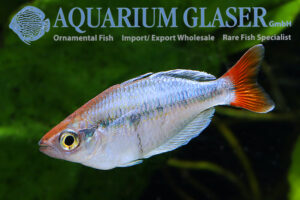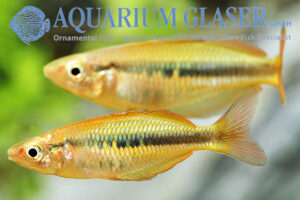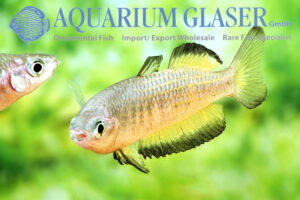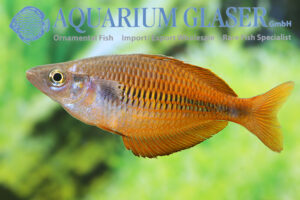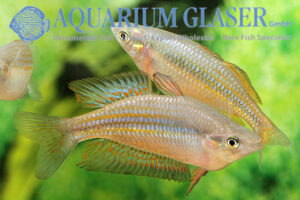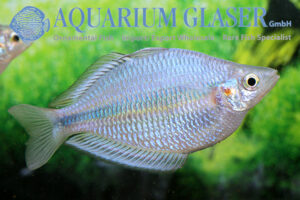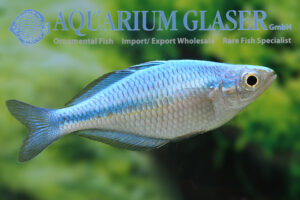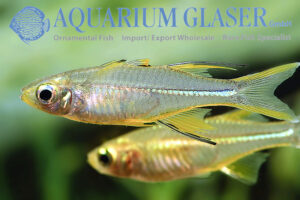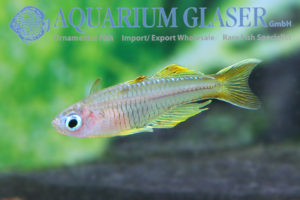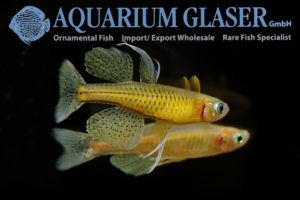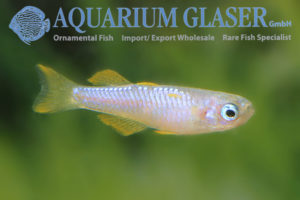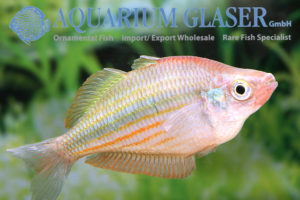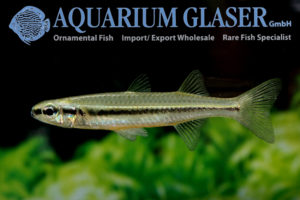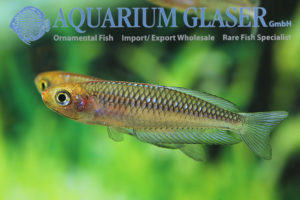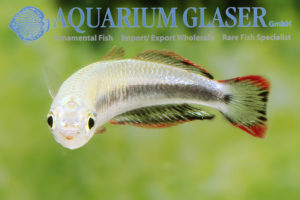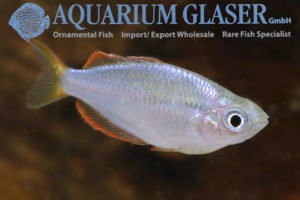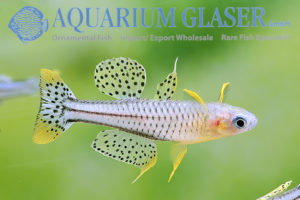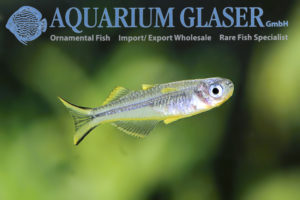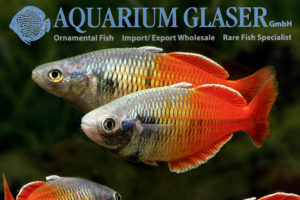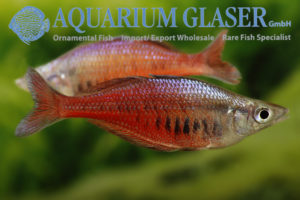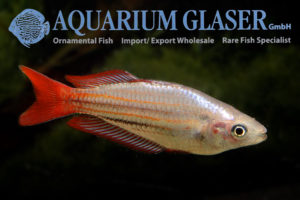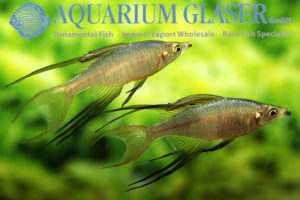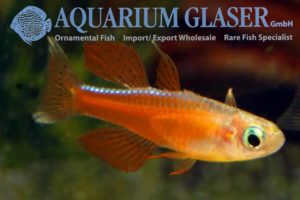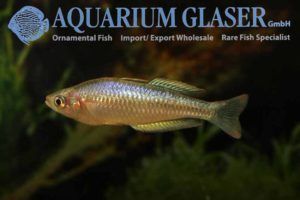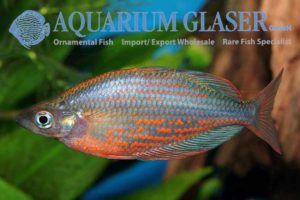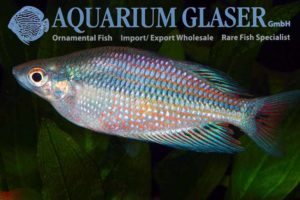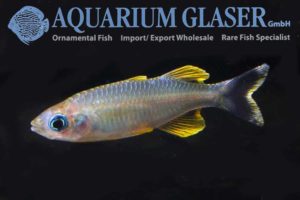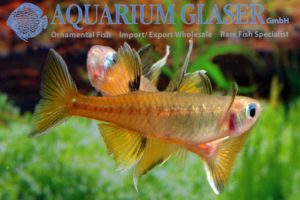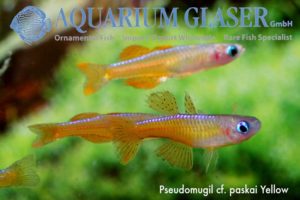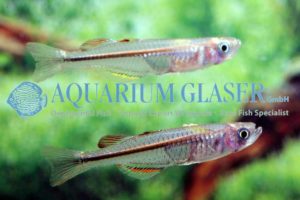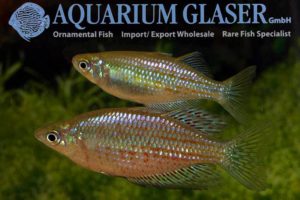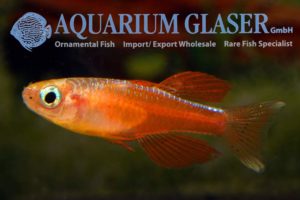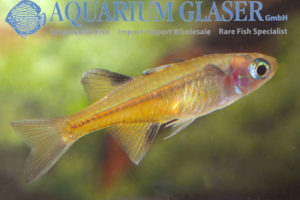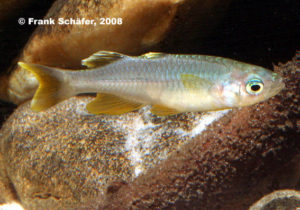This new dwarf rainbowfish, which has obviously not yet been scientifically described, was only introduced to the aquarium hobby in 2019. As is so often the case with rainbowfishes, it was found during a privately funded and conducted research trip. Its provisional name Melanotaenia sp. “Kali Tawa” refers to the place where it was found […]
17. Rainbow fishes and Co. (35)
-
-
Chilatherina alleni
The rainbowfish of the genus Chilatherina are found exclusively in New Guinea. The genus differs from the closely related genus Melanotaenia mainly in its jaw structure. To date, 11 species have been assigned to Chilatherina. One of the peculiarities of some species of this genus is that they change color strongly at an advanced age. […]
-
Melanotaenia parkinsoni
Melanotaenia parkinsoni is one of the few species of rainbowfish that are offered relatively regularly in the trade. The home of this maximum 14 cm long, but usually much smaller animal is in Papua New Guinea, in the Central Province. There are only confirmed specimens from the Kemp Welsh River, which is sometimes also referred […]
-
Melanotaenia fasinensis
The Bird’s Head Peninsula is part of the large island of New Guinea. It is located in the northwest of New Guinea and belongs politically to Indonesia (West Papua). For rainbowfish enthusiasts, it is currently the holy land, as the Bird’s Head Peninsula is a hotspot of diversity for this group of fish. The most […]
-
Melanotaenia splendida
The second species of rainbowfish of the genus Melanotaenia that was ever scientifically described was M. splendida. This was in 1866 and the description of the species is based on specimens from the Fitzroy River in Queensland, Australia. The species seemed so unusual to Peters, who first described it, that he even created a new […]
-
Melanotaenia goldiei „Kafiamke“
This species of rainbowfish from Papua New Guinea was scientifically described as early as 1883. However, it was not until around 100 years later that the first specimens were introduced into aquaria outside Australia, although M. goldiei is one of the most common and widespread species in the southern part of the island. As is […]
-
Melanotaenia lacustris
The rainbowfishes are a fascinating group of freshwater fishes from Australia and New Guinea; some smaller islands between these two major areas are also colonized by rainbowfishes, evidence that Australia and New Guinea once formed a common landmass when sea levels were much lower than today. This prehistoric landmass is called Sahul. Rainbowfish are almost […]
-
Marosatherina ladigesi
The Celebes Rainbow, Marosatherina ladigesi, is perhaps still remembered by some readers as Telmatherina ladigesi. The species lives endemically (i.e. – seen worldwide – exclusively there) in cool karst streams in the area around Bantimurung, Maros karst, Sulawesi Selatan; Sulawesi belongs politically to Indonesia, but zoogeographically to the Australian region. In former times the big […]
-
Pseudomugil ivantsoffi
This cute blue-eye originates from the surroundings of the town Timika in the Indonesian province Papua on New Guinea. It was discovered and scientifically described relatively late (1999); at first it was thought to be the same species as P. reticulatus, whose locality is about 900 km further northwest (seen from Timika). But then it […]
-
Pseudomugil gertrudae
This cute blue eye belongs to our standard offer; the animals are bred ones from Indonesia. Recently we received some very nice specimens. This “no name” variant stays a bit smaller (around 3 cm) than the popular variant from the Aru Islands (https://www.aquariumglaser.de/en/fish-archives/pseudomugil-gertrudae-aru-ii-xl-2/), which reaches almost 4 cm length. Pseudomugil gertrudae has a relatively wide […]
-
Pseudomugil luminatus „Blue“
From Indonesia have received once again Neon Blueeye under the name Pseudomugil paskai. The first Neon Blueeye, the “Red Neon” (P. luminatus), was a sensation (see https://www.aquariumglaser.de/en/fish-archives/pseudomugil_cf_paskai_red_neon_en/) and also the yellow variant is beautiful (see https://www.aquariumglaser.de/en/fish-archives/pseudomugil_cf_paskai_en/). Now we have obtained a third variant, which this time best corresponds to the “real” P. paskai, also a […]
-
Glossolepis spec. “Gidomen Village”.
In 2010 this beautiful rainbowfish was discovered on a private expedition in eastern West Papua. It lives there in the Taritatu River (former: Idenburg River). At first it was thought to be a Chilatherina species, but genetic studies rather point to Glossolepis. The species could be brought back alive and propagated in the aquarium. Nowadays […]
-
Craterocephalus stercusmuscarum
Similar to rainbowfishes, hardyheads (Craterocephalus) are exclusive elements of the Australian fauna. That is, they are found only on the Australian continent and offshore islands (including New Guinea) that formed the large landmass called the Sahul during the Ice Age. Craterocephalus have two separate dorsal fins and, like rainbowfishes, belong to the mullet relatives, but […]
-
Rhadinocentrus ornatus
An absolute rarity among the rainbowfish relatives is the ornate rainbowfish Rhadinocentrus ornatus. Within the genus Rhadinocentrus there is only one species, of which however several local variants exist. The reasons for the rarity of this fish in the hobby are that it is a subtropical species, so in the long run it needs certain […]
-
Bedotia geayi
This is the only almost always available aquarium fish that comes from the large, geologically old island of Madagascar. All other freshwater fishes from this island, which unfortunately are often threatened with extinction due to massive environmental changes, are only suitable for specialists. The beautiful Madagascar rainbow (Bedotia geayi) grows to a length of 10-12 […]
-
Melanotaenia praecox
The Diamond Rainbowfish – Melanotaenia praecox – is one of the smallest species of the actual rainbowfishes and grows only 6-7 cm long. It shows already from 3 cm length its splendid iridescent body coloration. That is why it is one of the most popular species in the trade. With age the males become high-backed […]
-
Pseudomugil gertrudae Aru II xl
The cute blue-eyes of the species Pseudomugil gertrudae are actually always in our stock. We usually get them as bred ones from Indonesia. Originally they are found in northern Australia and southern Papua New Guinea. At the moment we have fully grown, about 4 cm long animals in stock, which we received from a European […]
-
Pseudomugil furcatus (formerly Popondetta furcata)
The blue-eyes Pseudomugil furcatus, relatives of the rainbow fish, originate from the island of New Guinea. However, there are never wild catches of the maximum 6 cm long, peaceful schooling fish on the market, but only offspring, all of which go back to a single collection in 1981. Since then they have been bred continuously. […]
-
Glossolepis incisus
The red rainbow fish, Glossolepis incisus, is one of the magnificent classics among the rainbow fish. One can well understand that this fish caused real storms of enthusiasm in the 1970s, when only two relatively inconspicuous species of this group of fish were known in the hobby. The home of Glossolepis incisus lies in western […]
-
Melanotaenia boesemani Red
The blue-red Boesemans rainbow fish has not disappeared from the aquariums since its aquaristic discovery in 1981. For a time, it was so sought after that it was caught on a massive scale for export; these animals went almost exclusively to Japan, where were paid insane sums for them. There were even fears of overfishing […]
-
Chilatherina sentaniensis
110 yeras ago – 1907 – the German-Dutch scientist Max Weber described freshwater fishes from New Guinea, which have been collected by a scientific expedition to the island by the Netherlands in 1903. One of the new species was a rainbowfish. Weber named it Rhombatractus sentanienis. Nowadays we know that fish under the name of […]
-
Melanotaenia australis
One of the species of rainbowfishes with the longest aqurium history is the dwarf rainbowfish, Melanotaenia maccullochi. It reached Europe as early as 1934 and is kept and bred since then. However, if we order nowadays M. maccullochi from Indonesia we do not get this species, but another one which has only a rough similarity […]
-
Iriatherina werneri
Currently we have wonderful, fully grown specimens of the Threadfin Rainbowfish in stock. Like a butterfly its wings the male Threadfin Rainbowfish flaps its first dorsal fin during courtship. The males can be easily recognized by the long filaments of the second dorsal and the anal fin. The tender species attains a maximum length of […]
-
Pseudomugil sp. paskai Red-Neon has been described scientifically
Pseudomugil sp. “paskai Red-Neon” has been imported for the first time in 2012 and is for sure one of the most spectacular discoveries of aquarium fish in the millenium. Since the first importation the fish has been well established in the hobby and proofed as a beautiful, peaceful, and hardy ornamental fish. However, there was […]
-
Melanotaenia pygmaea
For the first time ever we obtained this charming rainbowfish from a breeder. The specific name “pygmaea” refers to a small body size. In fact our fish are full in coloration. They are currently about 4 cm long (total length). According to literature the maximum lengthin males is about 7 cm, whereas females always stay […]
-
Glossolepis dorityi „Lake Nenggwambu“
Glossolepis dorityi also originates from West Papua, like Melanotaenia rubrostriata „Dekai Village“ (see http://www.aquariumglaser.de/en/news/Melanotaenia_rubrostriata_Dekai_Village__en/). Males attain a maximum length of about 15 cm, females stay smaller. Sadly the females have only quite dull colours. Males need about one year to reach a length of 7-8 cm. At that size they already display a real firework […]
-
Melanotaenia rubrostriata „Dekai Village“
The village named Dekai is located in West Papua (formerly: Irian Jaya) in the district of Yahukimo. It seems to be a real hotspot for extremely beautiful species of rainbowfish. Many species and local varieties have been collected there in the past years and brought to the tanks of enthusiasts. This applies also for this […]
-
Telmatherina bonti (2)
The Malili lake system on Sulawesi (former Celebes) is home of spectacular shrimps, snails and mussels which are exported for the hobby. Now the import of an endemic atherinoid species was successful, namely Telmatherina bonti. Like many atherinoides of the Malili lakes this species is polychromatic, which means that males and females appear in different […]
-
Pseudomugil signifer GAP CREEK
One of our breeders has to reduce the number of tanks in his fish house and so we have the very rare opportunity to offer some valuables among the rainbowfishes with given locality and in fully grown specimens. One of them is Pseudomugil signifer from the Gap Creek – beautiful animals, aren’t they? For our […]
-
Pseudomugil luminatus “Yellow”
It has been only recently that we were able to present to you the sensational Pseudomugil luminatus “Red Neon” (see http://www.aquariumglaser.de/en/archiv.php?news_id=556). Now we received from one of our suppliers in Indonesia a new variety of that species which we called Pseudomugil luminatus “Yellow” due to the rather yellow basic coloration, compared with the “Red Neon”. […]
-
Pseudomugil pellucidus
For the first time ever we can offer this rare blue eye. The completely peaceful fish – they attain a maximum length of about 4 cm – a very interesting due to the fact that the stripe in the anal fin differs individually from yellow to red. For our customers: the fish have code 446153 […]
-
Melanotaenia rubrostriata
We obtained very nice German bred specimens of this colorful rainbowfish, which is found in the trade only very occasionally. Our specimens are currently 5-7 cm long. The species attains a maximum length of about 14 cm and each centimeter the fish grows it becomes even more colorful! For our customers: the fish have code […]
-
Pseudomugil luminatus Red-Neon
For the first time ever we have this charming dwarf in stock. Maximum length is around 3.5 cm in males, females stay smaller. For our customers: the animals have code 446453 on our stocklist. Please note that we exclusively supply the wholesale trade. Text & photos: Frank Schäfer
-
Pseudomugil signifer
The species of the genus Pseudomgil are relatives of the rainbowfishes. But they stay much smaller and usually they reach only 4-5 cm in length. This is also true for P. signifer, which looks a bit like a miniature edition of the Celebes rainbowfish (Marosatherina ladigesi). The males are displaying the whole day through what […]
-
Telmatherina bonti
The Malili lake system on Sulawesi (former Celebes) is home of spectacular shrimps, snails and mussels which are exported for the hobby. Now the import of an endemic atherinoid species was successful, namely Telmatherina bonti. Like many atherinoides of the Malili lakes this species is polychromatic, which means that males and females appear in different […]





